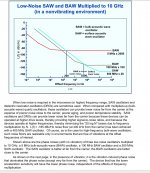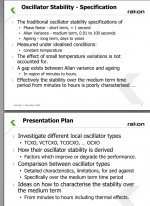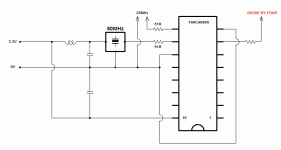Thanks for this, Joe. I just read the related material on your web site. Please correct me if I'm wrong, but it occurs to me that (following your "jitter is analogue" image) that jitter frequency would be (as with analogue waves) inversely proportional to 'wavelength'--in the time domain, presumably the number of clock cycles affected per 'cycle' of jitter (with jitter amplitude being the amount of phase shift per clock cycle). So very low frequency jitter (also called 'wander,' I believe) would, if this model holds, be that which shifts the signal across the largest number of clock cycles.
There are a number of ways of characterizing jitter. From lowest freq -> high
Long term drift = days / months / years
Allan deviation (or variance) = 0.1 sec to 1000 sec (or longer)
Phase noise plot = 1Hz to 1MHz from carrier.
If you are interested do some googling there are a number of pdf's and ppt
downloads to explain further. Too much to go into here.
If this is true, then it makes perfect sense that, other things being equal, the lower the frequency of jitter, the more distortion of the signal it would cause. A 1-Hz jitter component would affect, for instance, 44.1 thousand samples of a Red Book CD signal. A two-Hz jitter component would affect 22.05 thousand, etc. The additive effect of several low-frequency jitter components (even allowing for statistical cancelling out of some the huge sum of phase shifts) could, even if jitter amplitude were held constant across the jitter frequency spectrum, result in a potential for dramatic timing errors in signal reconstruction at all audio frequencies. Whereas higher-frequency jitter, affecting comparatively few clock cycles, would be more likely to inflect harmonics/timbre higher in the audio band, and their additive effects would be smaller.
It would be interesting, if adequately sensitive test and clock-perturbing equipment exists, to do listening tests on the effects of injecting different very narrow frequency bands of jitter on the same audio signal (clocked by something like the Rubidium clock), followed by the testing the effects of "stacking" several of those narrow bands of jitter, particularly at relatively low frequencies.
In any case, such a model would seem to confirm both the efficacy of ultra-low noise power supply design and construction (to power the digital circuitry) using known techniques, as well as of the discovery and implementation of clocks with optimum inherent stability (thus synchronous oscillators--rather than PLL--based on SAW devices would be candidates?). Given successful execution in these two areas, then one could look at minimizing sources of random rather than periodic jitter, such as thermal noise, etc.
I'd welcome comments on all the above--I am no specialist in this field and I could be way off base, or this could all be old hat to those in the know, but if it is, I don't think its impact on audiophile gear design has really hit home yet.
Thanks--this my first post, so please set any flamethrowers to "low."
There's too much to go into here. Rubidium are not necessarily good for audio
they are for long term time keeping. Short term phase noise can be poor.
Do some searching on phase noise of rubidium clocks to get up to speed
on their performance. There are ones that do have extremely good
performance at audio freq but these are VHQ OCXO's phase locked to the
Rub std.
WRT SAW oscillators / VLN power supplies:
There are efforts here (Joe) of going to large extremes to try and minimize
ultra LF noise in clock power supply. Even though PS may take 30 min to
ramp up, this doesn't mean it will have super low LF noise. The ramp up time
can be simply sped up with a few diodes. The LF noise generally comes
down to semiconductor 1/f noise. I don't see any projected specs or
measurements.
SAW oscillators generally have worse low frequency phase noise than
crystal (BAW) oscillators. Below 10Hz offset I don't know. I'd like to see
an Allan Dev. plot for SAW oscillator.
There are other factors like G sensitivity. Here I think SAW might be very
good.
So far I don't see much correlation between oscillator jitter and sound
quality. In fact it almost appears opposite.
They may well sound good but objectively speaking we are flying in the
dark here.
Just received '105 today. Only taken the top cover off.
I imagine, for ease, that I will be able to dispense of the 7.1 board while I actually work on the player. It should run in stereo mode without that 7.1 board - when finished, put it back.
This should make it a lot easier to work on than '95.
Even though much taller, internally this box is still fairly brim full. For the money paid, this is a lot of player.
Cheers, Joe R.
I imagine, for ease, that I will be able to dispense of the 7.1 board while I actually work on the player. It should run in stereo mode without that 7.1 board - when finished, put it back.
This should make it a lot easier to work on than '95.
Even though much taller, internally this box is still fairly brim full. For the money paid, this is a lot of player.
Cheers, Joe R.
The solution is to lift up all the output pins of the DAC and do another connections.
Hi Coris
I would definitely not attempt that, and won't have to.
Remove the I/V chips, then use/join pads for Pin 2 and Pin 6 on all of them, and they will be paralleled. Then use your own designed I/V stage etc.
We have worked on a number of Yamaha CD-S1000 and CD-S2000 CD/SACD Players, and there you had to join up pads as well because the Burr-Brown current DACs were is monaural mode (one for Left and the other for right) where each phase had its own I/V IC. Worked just fine.
Cheers, Joe R.
However, it is better to get rid of the summing opamp altogether and use a better IV converter then straight out through a coupling cap...way better. When you sum you are just adding the sound of another opamp and its passive components used (resistors, caps, solder joints). Less is better!
Hey Ric, that is right, and I did this first some years ago and used a coupling cap as the DC was not cancelled out. So what if I put a coupling cap in the signal path, on the output of the I/V (single-ended), it still sounded much better.
I recall the first one was the XA-9000ES Sony, when Sony went over to Burr-Brown DACs. Just use a decent cap.
Cheers, Joe R.
Volume control
I now have a bdp-105 at home, and I really like it. I use it to drive a pair of active monitors directly, which sounds great. The only thing I worry about is the fact that I find myself listening at volume levels mostly below 50, sometimes below 30. I have tried to find out more, but failed. Does anyone know how many dB per volume step the Sabre DAC attenuates?
And, more complicated, assuming that I have a good preamp (say noise and distortion are below -100dB), at what attenuation level will the digital volume control be worse than my
analoge preamp? ESS claim about 130dB s/n for the Sabre, so I would assume attenuating more than 30dB could make it worse than my preamp, all assuming that my preamp can retain 100dB s/n while attenuating more than 30dB, of course.
Obviously, I have tried both, and I think I prefer the direct connection, but it is still early days.
BTW, My preamp is a Django transformer preamp, using the S&B TX-102 transformers. (yes, 100dB is just a guess)
I now have a bdp-105 at home, and I really like it. I use it to drive a pair of active monitors directly, which sounds great. The only thing I worry about is the fact that I find myself listening at volume levels mostly below 50, sometimes below 30. I have tried to find out more, but failed. Does anyone know how many dB per volume step the Sabre DAC attenuates?
And, more complicated, assuming that I have a good preamp (say noise and distortion are below -100dB), at what attenuation level will the digital volume control be worse than my
analoge preamp? ESS claim about 130dB s/n for the Sabre, so I would assume attenuating more than 30dB could make it worse than my preamp, all assuming that my preamp can retain 100dB s/n while attenuating more than 30dB, of course.
Obviously, I have tried both, and I think I prefer the direct connection, but it is still early days.
BTW, My preamp is a Django transformer preamp, using the S&B TX-102 transformers. (yes, 100dB is just a guess)
Thanks--this my first post, so please set any flamethrowers to "low."
If that was your first post, then that may well qualify as the BEST first post ever.
Bravo!
Your explanation of "wander" seems spot on. In fact I wish I had come up with that, and indeed I shall use "wander" as a simplification. May I?
We know that somebody on the West Coast in the US is also looking closely at this - so some serious research is definitely happening. And in time I expect more will come to light and a wider general understanding. You certainly seemed to have grasped some of the complexities very well.
Cheers, Joe R.
Just received '105 today. Only taken the top cover off.
I imagine, for ease, that I will be able to dispense of the 7.1 board while I actually work on the player. It should run in stereo mode without that 7.1 board - when finished, put it back.
This should make it a lot easier to work on than '95.
Even though much taller, internally this box is still fairly brim full. For the money paid, this is a lot of player.
Cheers, Joe R.
Cheers for your new Oppo player!
It is interesting to see that it will work without the multichannel board on its place (connected I mean...). The 95 model did not worked (booted up) without multichannel DAC, or without that chip clocked...
As I could see, the firmware chips for both DACs are planted on the stereo board...
Anyway, just try without that board. I`m a little bit sceptic that the this model too will boot up without multichannel board.
Thanks for infos above....
Last edited:
Anyway, just try without that board. I`m a little bit sceptic that the this model too will boot up without multichannel board.
Not my '105 - but the first one here and over the next few weeks, as times allow, will certainly be looking at things.
To try without 7.1 Board, all I need to do is not to remove it, but simply disconnect the analog power supply harness/connector and also pull out the ribbon. I don't need to physically remove it. But right now I haven't even turned the player on yet.
Cheers, Joe R.
If that was your first post, then that may well qualify as the BEST first post ever.
Bravo!
Your explanation of "wander" seems spot on. In fact I wish I had come up with that, and indeed I shall use "wander" as a simplification. May I?
We know that somebody on the West Coast in the US is also looking closely at this - so some serious research is definitely happening. And in time I expect more will come to light and a wider general understanding. You certainly seemed to have grasped some of the complexities very well.
Cheers, Joe R.
Guys / Joe
I'm guessing 'wander' will come some where in the Allan Variance (Deviation)
and phase noise very close to carrier, say 1Hz offset. See attachment
below.
Joe, I'm guessing you are alluding to the fact that stability in the range
>10 sec is important? All your work seems to point in this direction. In this
case look at getting Allan Variance measurements for the oscillators and
look at phase noise 1Hz and below.
I would be surprised if stability in > 1000sec range is of critical importance,
interestingly, in the Rakon paper they suggest this range is not well
characterized.
At the end of the day, again, I still come back to the basic premise that we
have conflicting results here.
There is a huge effort placed on reducing LF noise in power supplies but all
the info I can turn up suggests SAW oscillators have worse low freq phase
noise and med / long term stability than BAW. Ref to attachment below.
I'm interested in any results or conclusions your people on west coast come
up with. However if they are to conclude anything meaningful, they will
have to get access to the specialised equipment required to measure these
areas of stability.
Attachments
Joe, I'm guessing you are alluding to the fact that stability in the range
>10 sec is important? All your work seems to point in this direction. In this
case look at getting Allan Variance measurements for the oscillators and
look at phase noise 1Hz and below.
.... I'm interested in any results or conclusions your people on west coast come
up with. However if they are to conclude anything meaningful, they will
have to get access to the specialised equipment required to measure these
areas of stability.
Hi Terry
I don't have any conclusive sub-1Hz data, other than Paul Miller's example. I am not saying it is conclusive, but it does at least point to a kind of mechanism at work:
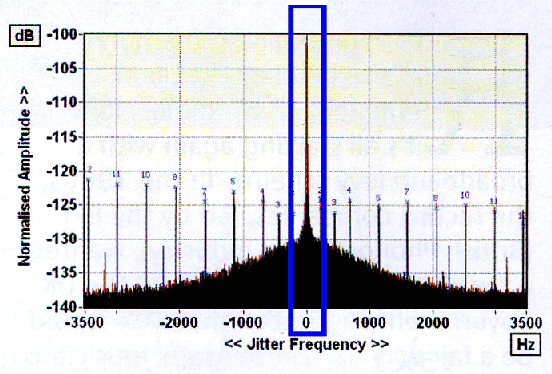
Using rather expensive equipment (and you yourself indicate some exotic equipment may be needed, read expensive) he used 100X magnification of the Blue Box area:
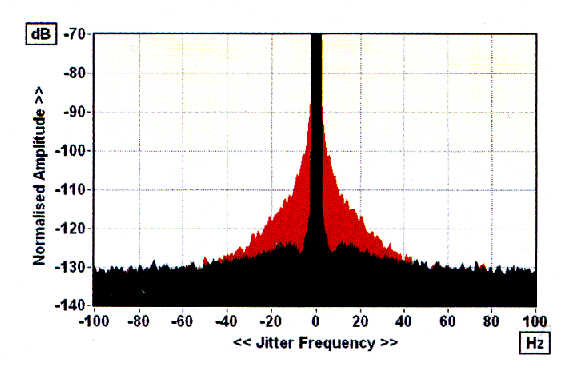
Same measurement, but the 'better' sounding player is Black and the less so Red. I can see Red cling right up to -70dB - and that's +60dB and maybe who knows how much worse? If the resolution was better, it could look truly frightening.
Even Miller himself did seem to know what he was seeing, and exactly where the noise comes from? It is power supply or...? Admittedly this is not an oscillator measurement, so I don't want to over-interpret it. But it is the first time somebody came across it and put a description on it: "Low rate, uncorrelated or noise-like jitter"
Also, that measurement starts at a much higher frequency, but that is neither here or there, it is that climb and would not also the windowing affect the interpretation of the frequency near the carrier? But it's the amplitude that is disturbing, as it climbs the carrier.
I am just struck by the fact that here is something not many people has commented on, and by some a lot smarter than me can figure out if this is a trend or characteristic that is repeated in a number of, for want of a better word, situations, oscillators included?
However if they are to conclude anything meaningful, they will
have to get access to the specialised equipment required to measure these
areas of stability.
Yes, since if you extrapolate what your Rakon measurement down down to near 1 Hertz would indicate nothing, just mostly a straight line upwards and is there is potentially another trend below that at much lower frequency?
That could be Allan Variance/stability?
I suspect you have your doubts about that. I can understand that. But I am not so sure. To be honest, I don't know.
In my mind, I suppose that the window sub-1Hertz is then still, to a degree, an open book. That Miller measurement... it just gives me more and more food for thought?
ATTENTION Coris:
Of the 100MHz Oscillators you tried on the Sabre DAC, was one of them a Crystek 957 as used by the Buffalo guys?
What we desperately need to know whether anyone has compared it to a 100MHz SAW.
I have a friend who watches this thread, who has offered to send a spare 957 Oscillator to me, he likewise is going to run the comparison the opposite way, going from Crystek to SAW, and I will go from SAW to Crystek.
Will I be disappointed if the Crystek "BAW" sounds better than the "SAW"?
Most definitely not!
I will then definitely want to use it !!!
But IF the SAW sounds better, then in the light of above, there are questions to be asked and answers to be got.

Cheers, Joe R.
Last edited:
The new Crystek oscillators are the new industry standard low jitter clocks....many, many companies are using these on their digital input boards. I use them with great results. I have not played with any see SAWs. Of course, I want the SAWs to win....they are much cheaper!
The new Crystek oscillators are the new industry standard low jitter clocks....many, many companies are using these on their digital input boards. I use them with great results. I have not played with any see SAWs. Of course, I want the SAWs to win....they are much cheaper!
I just hope my excitement isn't getting me into trouble. I haven't tried the Crystek and I have no doubt it is very good, and now I wish maybe I shouldn't have open my big mouth too soon? But we will find out for sure. The SAWs have not been considered for audio before, so it may yet surprise. They sure have surprised me, and I know they are good, but how good?
Is the Crystek available in 27MHz?
Cheers, Joe R.
ATTENTION Coris:
Of the 100MHz Oscillators you tried on the Sabre DAC, was one of them a Crystek 957 as used by the Buffalo guys?
Yes, I have tried in 95 (stereo stage) the 100Mhz Crystek 957 used in Buffalo 3. I had not an 100Mhz SAW to compare, but I can say that ESS9018 sounds better with 125Mhz SAW oscillator than with an 125Mhz standard one.
Anyway, I do not want go back to 100Mhz. The DAC chip it sounds better with higher clock frequencies than 100Mhz. Honestly, I do not know why...
The new Crystek oscillators are the new industry standard low jitter clocks....many, many companies are using these on their digital input boards. I use them with great results. I have not played with any see SAWs. Of course, I want the SAWs to win....they are much cheaper!
What about trying SAW? Why not? Waiting for you opinions after doing so...
Yes, I have tried in 95 (stereo stage) the 100Mhz Crystek 957 used in Buffalo 3. I had not an 100Mhz SAW to compare, but I can say that ESS9018 sounds better with 125Mhz SAW oscillator than with an 125Mhz standard one.
Anyway, I do not want go back to 100Mhz. The DAC chip it sounds better with higher clock frequencies than 100Mhz. Honestly, I do not know why...
Thanks Coris.
Well, that is certainly interesting. I did not find much of a difference between the 100MHz SAW and the 125MHz SAW - but I did get a few glitchy noises with one Oppo 95 and that went away when I replaced it with 100MHz SAW, and still heard those SAW qualities shine through.
Are we on to something new here? I am grateful to Coris for trusting me to try the SAW - and I did not know at the time he had also used the Crystek 957.
I know my friend in Malaysia has the Buffalo, and he reads this thread (Hi David) and he is going to try the SAW in place of the Crystek. So we should arrive at a consensus of opinion.
For those here, the Epsom 100MHz SAW is available from Farnel/Element14 - and the part number is 1907482.
The Oz website is: XG-1000CA 50.00MHZ 100PPM CC - EPSON TOYOCOM - OSC, SAW, 50.00MHZ, 100PPM, 3 | element14 Australia
Yes, they are cheap. But Epson also make a more expensive range and when you compare the relevant specs, they are basically the same. I can only think that this has something to do with scale of production and that they have made a stack of them. They are not that hard to get.
Cheers, Joe R.
PS: It's important to have a Ferrite Bead right on to the SAW 3.3V input and I also put a 10-22uF Murata SMD after the bead. or you may get glitchy noises.
Last edited:
I just hope my excitement isn't getting me into trouble. I haven't tried the Crystek and I have no doubt it is very good, and now I wish maybe I shouldn't have open my big mouth too soon? But we will find out for sure. The SAWs have not been considered for audio before, so it may yet surprise. They sure have surprised me, and I know they are good, but how good?
Is the Crystek available in 27MHz?
Cheers, Joe R.
I have used the bran new 24,576Mhz Crystek oscillator (not in BDP95). Good results! They may produce 27Mhz too. But they have for sure 54Mhz, 108Mhz...
Based on your idea, I think I want experiment more with divided clocks (using higher frequencies oscillators) for the main processor in 105.
Last edited:
I have used the bran new 24,576Mhz Crystek oscillator (not in BDP95). Good results! They may produce 27Mhz too. But they have for sure 54Mhz, 108Mhz...
Based on your idea, I think I want experiment more with divided clocks (using higher frequencies oscillators).
Yes, in the Oppo 105 we may consider using SAW on the DAC and Crystek on the Mainboard.
Cheers, Joe R.
Based on your idea, I think I want experiment more with divided clocks (using higher frequencies oscillators) for the main processor in 105.
Here is what I am using with 50MHz SAW divided down to 25MHz in Oppo 95.
Attachments
Last edited:
ATTENTION ALL:
I think this is good news. I disconnected power from the 7.1 Board as well as the ribbon from the Stereo Board - it means the 7.1 Board is only mechanically fitted to the player, then turned it on, and played a test CD and I am looking at a nice sine wave on the scope. So it seems we can remove it all together, work on the Stereo side and when finished, pop it back.
Cheers, Joe R.
I think this is good news. I disconnected power from the 7.1 Board as well as the ribbon from the Stereo Board - it means the 7.1 Board is only mechanically fitted to the player, then turned it on, and played a test CD and I am looking at a nice sine wave on the scope. So it seems we can remove it all together, work on the Stereo side and when finished, pop it back.
Cheers, Joe R.
I see the heatsink on the Mediatek chip, this is some kind of clip into hole arrangement? I think the 27MHz clock is obscured by the heatsink. I seem to recall Ric saying that.
What's the correct technique to remove it, push down and release and then when you return it, push it and it will lock?
No rush, so taking my time. Is the above method correct ?
Cheers, Joe R.
What's the correct technique to remove it, push down and release and then when you return it, push it and it will lock?
No rush, so taking my time. Is the above method correct ?
Cheers, Joe R.
- Home
- Source & Line
- Digital Source
- Oppo's BDP105 - discussions, upgrading, mods...
